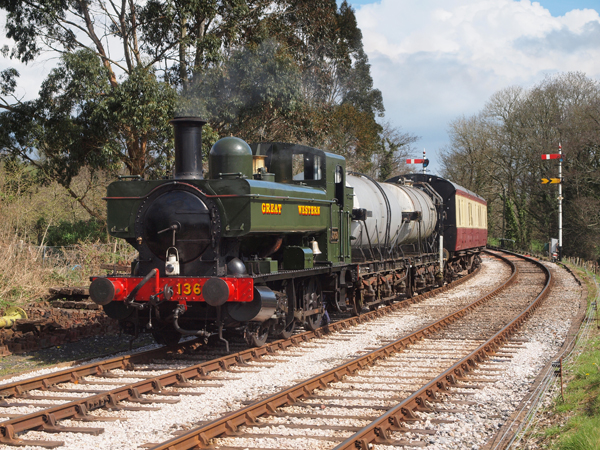SOUTH DEVON RAILWAY — 1872 – 2012
 | |
| 1369 with a Milk train rests in the loop at Bishops Bridge Easter 2012 | ©Tim Symons |
Today’s South Devon Railway originally ran for nine miles from Totnes, where it joins the Plymouth to Exeter main line, to the ancient Stannary town of Ashburton. The South Devon Railway first arrived in Totnes in 1847 and plans to link it to Ashburton began immediately.
There had been several schemes in the mid 1800’s to link Buckfastleigh and Ashburton to the fast growing railway network. The main line from Plymouth to Exeter was built by the original South Devon Railway. A group of local promoters came up with a plan to link Ashburton to Newton Abbot and in 1848 a Bill for a ten and a half mile branch received Royal Assent.
The great Isambard Kingdom Brunel was asked to be the engineer for the line. But with the economy in recession, the plan was dropped. Eventually another scheme, also to be built to Brunel’s broad gauge of 7’0¼" along the river Dart linking up with the South Devon Railway at Totnes was agreed upon, and the line opened on 1st May 1872 as the Buckfastleigh, Totnes and South Devon Railway: the line was originally planned not to link with Ashburton and needed another Act of Parliament to approve the extension!
Operated by the original South Devon Railway (Owner 1) , this company was taken over by the Great Western Railway (Owner 2) in 1876. The line, along with all the GWR’s broad gauge lines, was converted to George Stephenson’s narrow or standard gauge (4’8½" over one weekend in May 1892, a remarkable undertaking involving a massive workforce. Brunel was an incredibly gifted engineer and, had his broad gauge won the day, then our railway trains today would not only be faster but also would have a much greater passenger carrying capacity too.
The Ashburton line’s history is a quiet one — more of a twig than a true branch line -- and it is a sobering thought that it never ever made a profit! Goods traffic -- mainly coal, wool, cider and agricultural items -- were the core business of the line. Nationalisation came in 1948 and the line then became part of the Western Region of British Railways (Owner 3) But with the coming of the motor car era from 1925, takings rapidly declined until 3rd November 1958 when the last passenger train ran and long before even Dr. Beeching came on the scene to wield his infamous axe on so many railway lines. Freight continued for four short years until 7th September 1962. The line looked doomed!
But, in that year, the local press revealed that a group of businessmen was planning to reopen the line as a steam operated branch line and a commercial tourist company, the Dart Valley Light Railway Ltd, was born (Owner 4) . On 2nd October 1965, the first rolling stock arrived in GWR locomotives Nos. 4555 and 3205 and four BR(W) auto trailers.
The first passenger trains ran on the Dart Valley Railway on 5th April 1969, hauled by GWR pannier tank locomotive 6412. The official opening, undertaken by no less than Dr Richard Beeching, followed on 21st May 1969.
Sadly, the last two miles of the line to Ashburton were never operated for public services and in 1971, a year short of the line’s centenary, the line was severed to make way for the widening of the A38 and the beautiful Brunel station at Ashburton lost its trains forever.
Later, in 1989, the Dart Valley Railway company announced that the line was ‘uneconomic’ and decided to find another operator, or close it for the second time! The volunteers who had been involved with operating the line realised this was now their chance to form a company to take over the railway and run it as a registered charity. Fortunately, there was a registered charity already based on the line, Dumbleton Hall Locomotive Ltd, restoring GWR No. 4920 Dumbleton Hall. Its Articles of Association allowed it to run a railway, so it took over the lease of the Buckfastleigh branch on 1st January 1991.
The charity was renamed the South Devon Railway Trust (Owner 5) and the railway was renamed the South Devon Railway, the name of the first company to run trains over the line. The volunteer supporting body was similarly renamed the South Devon Railway Association. The first train under SDR operation ran on 29th March 1991 with BR(W) pannier tank locomotive 1638 and a rake of former BR coaches, all hired from the Dart Valley company.
In 2000, the SDR started negotiations to purchase the freehold of the line from the DVR for £1.15m, the money being raised through a share issue, loans, donations and revenue.
In 2002, the DVR granted the SDR a 199 lease on condition of a new Transport & Works Order being granted to the SDR (a legal requirement), which would grant the final transfer of the freehold title from the DVR to the SDR for the payment of a nominal £1.
In 2007, the line carried over 100,000 passengers for the first time under SDR operation and was named Heritage Railway of the Year and in 2009 celebrated the 40th anniversary of the line's reopening.
On 8th February 2010, the last step of the protracted TWO process was at last completed, the SDR paid the nominal £1 and became masters of their own destiny!
Last year, in 2011, the SDR carried 112,000 passengers – far more people than it ever would have seen under most of the previous owners and the line has a rosy future!

